DV Lottery photo requirements
The photo requirements for the DV Lottery are rigorous. Even minor deviations will result in your immediate disqualification by the US authorities. To prevent this, we will guide you through the DV Lottery photo process and get you one step closer to getting your Green Card.
What are the DV Lottery photo requirements?
The US government has established precise photo rules for the yearly DV Lottery. They determine the format, size, and age of the photos to be submitted and specify rules for wearing glasses and headgear.
These rules apply to all pictures you are submitting. You might ask yourself: how many images are even needed for the DV Lottery? The answer: one picture for each person who would acquire the right to a Green Card due to your DV Lottery win.
Therefore, you must submit a picture of yourself, your spouse (if applicable), and your children.
Using passport photos for the DV Lottery
For your DV Lottery registration, you should not use the same photo as in your passport unless it is very new. Why? The US authorities will compare your DV Lottery photo with your passport and might conclude that the picture is not up to date. But how old may a Green Card photo be?
DV Lottery photo age
The submitted photo for the DV Lottery may not be verifiably older than six months and must match your current appearance. Therefore, do not use images from the previous DV Lottery year. The US authorities take a close look at the photo. Registering with an old picture will lead to your disqualification.
However, there is a trick to “disguise” a slightly too old photo and make it work for the DV Lottery process. Your Green Card advisors from The American Dream know how it’s done and are happy to assist you. To use this service, register now.
Note: We remove all EXIF-data from photos before submitting them. If you submit a slightly older picture, it will not be recognizable by the US authorities as long as you apply via dvlottery.com.
DV Lottery photo background
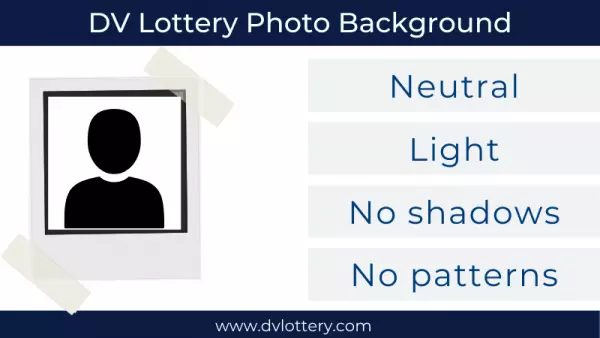
Your DV Lottery photo must have a light and neutral background without any shadows or patterns. So if you take the picture yourself, the best would be to stand in front of a white wall.
Head position for DV Lottery photo
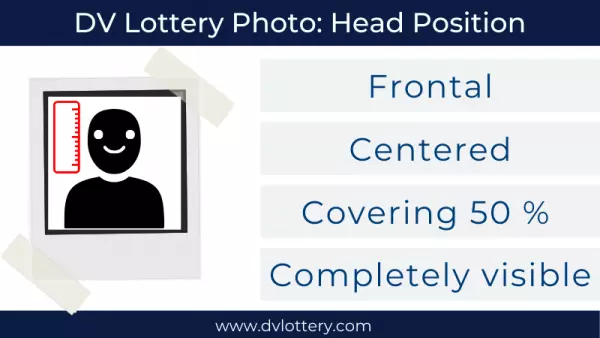
Your head has to be completely visible and centered in the photo, taking up around 50 % of the whole picture. Face the camera directly, pull your hair back and keep your eyes fully open and visible (no glasses allowed). The most important question at this point is: “Can you smile in a US visa photo?” Here is the answer:
Smiling in DV Lottery photos
In your DV Lottery photo, a gentle smile is allowed. Big smiles, however, lead to disqualification. To be on the safe side, you should use a neutral facial expression and don’t show your teeth in your Green Card photo.
Headscarves, kippahs, and the like in DV Lottery photos
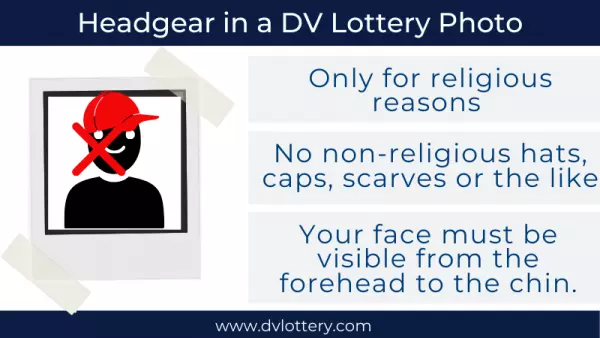
Head coverings are only permitted in DV Lottery photos when worn for religious reasons. However, the face must be visible from the forehead to the chin.
Non-religious headgear is not allowed in the image for the DV Lottery registration. Wearing a baseball cap, hat, beanie, or similar headgear will lead to disqualification.
Wearing glasses in a DV Lottery photo
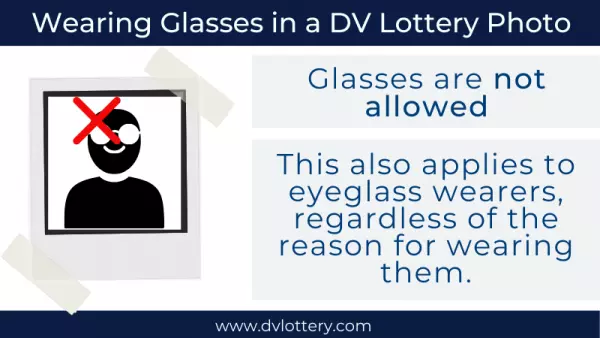
You cannot wear glasses or sunglasses in a DV Lottery photo, even if you usually wear them as a visual aid. In very rare cases where eyeglasses may not be removed for medical reasons, you can leave them on but have to provide a medical statement signed by your doctor.
What to wear in a Green Card photo
Given all the rules involving headgear and glasses, it's no wonder many people are worried about their looks in the photo. So what should you wear in a Green Card photo?
As long as your face is fully visible from the forehead to the chin, there is no dress code. With one exception: you should not wear a uniform or camouflage look.
Is a beard allowed in the DV Lottery photo?
The rules say: your DV Lottery photo must reflect your current look. But there is a little margin: growing or shaving a beard and even coloring your hair is acceptable, even if your current look differs from the one on your Green Card photo.
However, after undergoing body changes, you must ensure you can still be identified from the photo you submitted. So how much can you change your look before taking a new DV Lottery photo? Here are some reasons to better take a new photo:
- Facial surgery or trauma
- Adding or removing a large number of piercings or tattoos
- Significant weight loss or gain
- A new gender identity
Digitally edited photos for the DV Lottery
Unless you are very experienced with photo editing software, you should not digitally edit your DV Lottery photo. The reason is that a poorly edited image can have deviations from reality that lead to disqualification by the US authorities.
But if not with photo editing software, how do you resize a photo for the DV Lottery? The DV Lottery photo tool will assist you while applying on dvlottery.com and help you submit your photo in the right format.
With this software integrated into the application process, you can:
- Automatically remove photo backgrounds
- Automatically resize the photo
- Check the correct head size and position
- Check the correct image resolution
- with just a click!
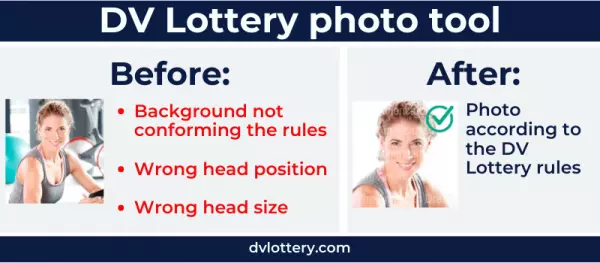
Of course, instead of squeezing a not-quite-suitable photo into the photo tool: why not take your own Green Card photo with your phone?
How to make your own DV Lottery photo
If you plan to take the photo for your DV Lottery application yourself, make sure you have a good (smartphone) camera available. Stand in front of a plain white wall or use the help of a white sheet.
Also, make sure you have enough lighting and that there are no shadows on your face or in the background. When taking the photo, hold the camera in front of your torso at a sufficient distance.
DV Lottery photo size and format
When registering for the DV Lottery, you must submit a digital photo whose size is between 600x600 pixels and 1200x1200 pixels. It may not exceed 240 KB and must be a high-quality JPG (JPEG) without blurry or unsharp areas or visible pixels.
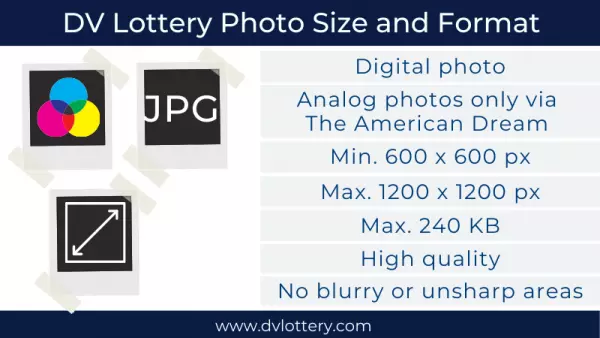
Color grading and contrast
For the DV Lottery, you must submit a full-color photo with a minimum color depth of 24 bits. You may not register with a black-and-white image.
Analog photos for the DV Lottery
When registering directly with the US authorities, it is not possible to submit analog photos. However, when participating with The American Dream, you may send in printed or analog pictures, which we will digitize on your behalf. The submitted photo should be 51x51mm.
Scanned photos for the DV Lottery
You may submit a scanned photo when registering for the DV Lottery. However, make sure it meets all the requirements for DV Lottery photos. Scan the print with a resolution of 300 dpi and ensure that the scan is sharp and clear without blurry areas or shadows.
We are happy to support you in digitizing your photo. To use our service, apply for the DV Lottery here.
Children and babies in DV Lottery photos
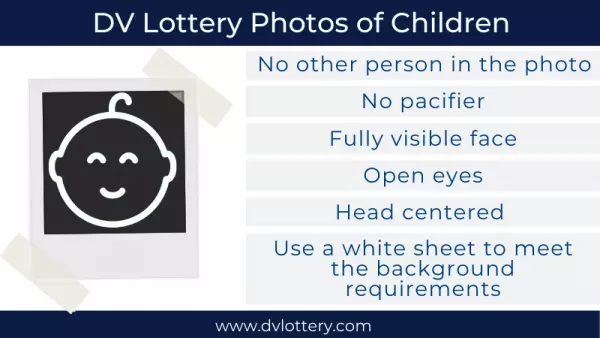
When taking photos of your infants, make sure there is no other person in the picture. The child may not wear a pacifier, their face must be fully visible, and their eyes have to be open.
To meet the background requirements (light and neutral), you can use a white sheet. It can take some time to get a decent photo of a baby. Therefore, can you submit DV Lottery photos after your registration?
Submit DV Lottery photos later
When registering for the DV Lottery via The American Dream, you can take your time and hand in your photo(s) later.
We provide registration all year round to ensure you have enough time to take your photo(s) according to the strict DV Lottery photo requirements and, if necessary, make subsequent corrections. To benefit from this service, register for your Green Card on dvlottery.com.
The team of The American Dream will double-check and verify the accuracy of your DV Lottery registration, data, and photo before submitting your application to the US authorities in due form and time.
Note: Should you register directly with the US authorities, you must submit everything immediately. Also, registration on the US state website is only possible for about four weeks in October/November every year.
| Submitting DV Lottery photo(s) | via dvlottery.com | via U.S. Department of State website |
|---|---|---|
| Brief double check if the photo meets the requirements | ✅ | ❌ |
| Feedback on your photo and a chance to correct faulty images | ✅ | ❌ |
| Submission all year round | ✅ | ❌ |
| Direct contact person | ✅ | ❌ |
| Later photo submission (after registration) possible? | ✅ | ❌ |
Replace DV Lottery photo after registration
After registering for the DV Lottery directly with the US authorities, it is not possible to make changes to photos once they are submitted.
Should you find out that your photo does not meet one of the requirements after registering, there is no way around being disqualified.
Note: The US authorities will not inform you if your photo is incorrect. Your only chance for a brief double-check, professional feedback, and a correction loop is to apply via dvlottery.com
The earlier, the better: when applying via dvlottery.com, you can also take advantage of our early-bird discount.
Summary: all rules for your DV Lottery photo
If you want to succeed in the DV Lottery, make sure you stick to all of the DV Lottery photo rules. Here is your summarized DV Lottery photo checklist:
| Requirements | |
|---|---|
| Background | Bright and neutral |
| Head size | The face (from chin to hair) must be around 50 % of the total height of the photo. |
| Head position | Straight look into the camera |
| Light | Must not be overexposed or underexposed. No shadows! |
| Digital editing | Not recommended |
| Face | Must not be covered by hair. The facial expression should be neutral. |
| Headgear | Not permitted except for religious reasons |
| Glasses | Not permitted |
| Picture size | 51x51mm |
| Resolution | 600x600 px |
| File size | Maximum 240 KB |
| Format | JPG, JPEG |
| Photo age | The photo must not be verifiably older than six months. |
The team of The American Dream has been helping people on their way to the USA for almost 30 years. Find out more about our service and fees.

